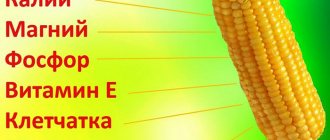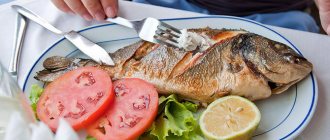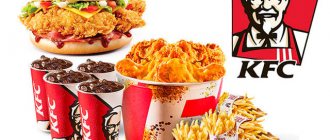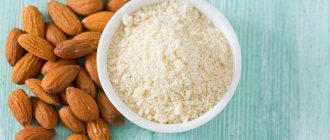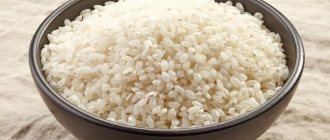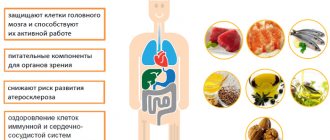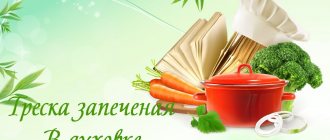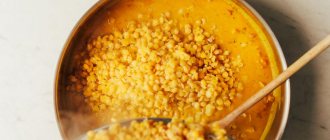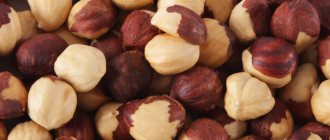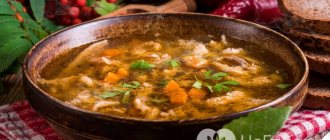Properties of trout fish
Nutritional value and composition | Vitamins | Minerals
How much does trout fish cost (average price per 1 kg)?
Moscow and Moscow region.
518 rub.
Trout belongs to the fish of the salmonidae order of the salmon family. Its body is elongated and slightly compressed from the sides, while the scales of the fish are quite small. The body color of a trout fish directly depends on the habitat of this beauty. Some types of trout are distinguished by their beautiful rainbow colors, which play in the sun and shimmer with all the colors of the rainbow. On average, it reaches one kilogram in weight, and can be up to half a meter in length.
Most often, trout fish live in the cool water of rivers and streams, mostly mountainous. It is desirable that the water be saturated with oxygen and there be a sufficient number of secluded places where it could hide.
It is interesting that the meat of this fish can differ in color: sometimes the flesh is yellow, but sometimes it is white or pink. There is an opinion that the color of trout fish meat depends on its diet.
In cooking, trout is highly valued due to the high taste of its fatty meat. Grilling is considered the best option for culinary processing, as almost all the beneficial properties of this fish are preserved. In addition, it is also suitable for frying or baking. When choosing trout fish, first of all you should pay attention to the smell, which is almost absent in a fresh specimen. In addition, a high-quality fish fillet should be elastic and resilient, and spring back when pressed.
Calorie content Trout, all types. Chemical composition and nutritional value.
Nutritional value and chemical composition of “Trout, all types.”
The table shows the nutritional content (calories, proteins, fats, carbohydrates, vitamins and minerals) per 100 grams of edible portion.
| Nutrient | Quantity | Norm** | % of the norm in 100 g | % of the norm in 100 kcal | 100% normal |
| Calorie content | 148 kcal | 1684 kcal | 8.8% | 5.9% | 1138 g |
| Squirrels | 20.77 g | 76 g | 27.3% | 18.4% | 366 g |
| Fats | 6.61 g | 56 g | 11.8% | 8% | 847 g |
| Water | 71.42 g | 2273 g | 3.1% | 2.1% | 3183 g |
| Ash | 1.17 g | ~ | |||
| Vitamins | |||||
| Vitamin A, RE | 17 mcg | 900 mcg | 1.9% | 1.3% | 5294 g |
| Retinol | 0.017 mg | ~ | |||
| Vitamin B1, thiamine | 0.35 mg | 1.5 mg | 23.3% | 15.7% | 429 g |
| Vitamin B2, riboflavin | 0.33 mg | 1.8 mg | 18.3% | 12.4% | 545 g |
| Vitamin B4, choline | 65 mg | 500 mg | 13% | 8.8% | 769 g |
| Vitamin B5, pantothenic | 1.94 mg | 5 mg | 38.8% | 26.2% | 258 g |
| Vitamin B6, pyridoxine | 0.2 mg | 2 mg | 10% | 6.8% | 1000 g |
| Vitamin B9, folates | 13 mcg | 400 mcg | 3.3% | 2.2% | 3077 g |
| Vitamin B12, cobalamin | 7.79 mcg | 3 mcg | 259.7% | 175.5% | 39 g |
| Vitamin C, ascorbic acid | 0.5 mg | 90 mg | 0.6% | 0.4% | 18000 g |
| Vitamin D, calciferol | 3.9 mcg | 10 mcg | 39% | 26.4% | 256 g |
| Vitamin D3, cholecalciferol | 3.9 mcg | ~ | |||
| Vitamin E, alpha tocopherol, TE | 0.2 mg | 15 mg | 1.3% | 0.9% | 7500 g |
| Vitamin K, phylloquinone | 0.1 mcg | 120 mcg | 0.1% | 0.1% | 120000 g |
| Vitamin RR, NE | 4.5 mg | 20 mg | 22.5% | 15.2% | 444 g |
| Macronutrients | |||||
| Potassium, K | 361 mg | 2500 mg | 14.4% | 9.7% | 693 g |
| Calcium, Ca | 43 mg | 1000 mg | 4.3% | 2.9% | 2326 g |
| Magnesium, Mg | 22 mg | 400 mg | 5.5% | 3.7% | 1818 |
| Sodium, Na | 52 mg | 1300 mg | 4% | 2.7% | 2500 g |
| Sera, S | 207.7 mg | 1000 mg | 20.8% | 14.1% | 481 g |
| Phosphorus, Ph | 245 mg | 800 mg | 30.6% | 20.7% | 327 g |
| Microelements | |||||
| Iron, Fe | 1.5 mg | 18 mg | 8.3% | 5.6% | 1200 g |
| Manganese, Mn | 0.851 mg | 2 mg | 42.6% | 28.8% | 235 g |
| Copper, Cu | 188 mcg | 1000 mcg | 18.8% | 12.7% | 532 g |
| Selenium, Se | 12.6 mcg | 55 mcg | 22.9% | 15.5% | 437 g |
| Zinc, Zn | 0.66 mg | 12 mg | 5.5% | 3.7% | 1818 |
| Essential amino acids | |||||
| Arginine* | 1.243 g | ~ | |||
| Valin | 1.07 g | ~ | |||
| Histidine* | 0.611 g | ~ | |||
| Isoleucine | 0.957 g | ~ | |||
| Leucine | 1.688 g | ~ | |||
| Lysine | 1.907 g | ~ | |||
| Methionine | 0.615 g | ~ | |||
| Threonine | 0.911 g | ~ | |||
| Tryptophan | 0.233 g | ~ | |||
| Phenylalanine | 0.811 g | ~ | |||
| Nonessential amino acids | |||||
| Alanin | 1.256 g | ~ | |||
| Aspartic acid | 2.127 g | ~ | |||
| Glycine | 0.997 g | ~ | |||
| Glutamic acid | 3.1 g | ~ | |||
| Proline | 0.734 g | ~ | |||
| Serin | 0.847 g | ~ | |||
| Tyrosine | 0.701 g | ~ | |||
| Cysteine | 0.223 g | ~ | |||
| Sterols (sterols) | |||||
| Cholesterol | 58 mg | max 300 mg | |||
| Saturated fatty acids | |||||
| Saturated fatty acids | 1.149 g | max 18.7 g | |||
| 14:0 Miristinovaya | 0.185 g | ~ | |||
| 16:0 Palmitinaya | 0.815 g | ~ | |||
| 18:0 Stearic | 0.148 g | ~ | |||
| Monounsaturated fatty acids | 3.254 g | min 16.8 g | 19.4% | 13.1% | |
| 16:1 Palmitoleic | 0.701 g | ~ | |||
| 18:1 Oleic (omega-9) | 1.44 g | ~ | |||
| 20:1 Gadoleic (omega-9) | 0.28 g | ~ | |||
| 22:1 Erucic (omega-9) | 0.83 g | ~ | |||
| Polyunsaturated fatty acids | 1.499 g | from 11.2 to 20.6 g | 13.4% | 9.1% | |
| 18:2 Linolevaya | 0.175 g | ~ | |||
| 18:3 Linolenic | 0.155 g | ~ | |||
| 18:4 Steoride Omega-3 | 0.064 g | ~ | |||
| 20:4 Arachidonic | 0.189 g | ~ | |||
| 20:5 Eicosapentaenoic acid (EPA), Omega-3 | 0.202 g | ~ | |||
| Omega-3 fatty acids | 1.132 g | from 0.9 to 3.7 g | 100% | 67.6% | |
| 22:5 Docosapentaenoic acid (DPA), Omega-3 | 0.183 g | ~ | |||
| 22:6 Docosahexaenoic acid (DHA), Omega-3 | 0.528 g | ~ | |||
| Omega-6 fatty acids | 0.364 g | from 4.7 to 16.8 g | 7.7% | 5.2% |
The energy value of Trout, all types is 148 kcal.
- 3 oz = 85 g (125.8 kcal)
- fillet = 79 g (116.9 kcal)
Primary source: USDA National Nutrient Database for Standard Reference. Read more.
** This table shows the average levels of vitamins and minerals for an adult. If you want to know the norms taking into account your gender, age and other factors, then use the “My Healthy Diet” application.
The benefits of trout
Regular consumption of this fish meat has a beneficial effect on the human condition. The benefits of trout are manifested in the ability to reduce the level of bad cholesterol in the blood, as well as strengthen the arteries and stimulate the brain, so doctors recommend eating this product as often as possible in case of Alzheimer's disease and some heart diseases.
The high content of some macro- and microelements gives trout a number of healing properties. For example, the benefits of trout as a natural stimulator of blood circulation, which can prevent the formation of blood clots, are obvious. In addition, metabolic processes are activated and the functioning of many body systems is normalized.
How many calories are in trout
Trout is a high quality fish; it lives only in clean waters, and therefore is considered extremely clean and healthy.
During diets, it is recommended to eat lean fish - it is high in protein and low in calories. And trout - is it a dietary fish? How many calories are in trout and is it possible to eat trout during a diet? Trout, like all fish, does not contain carbohydrates. Its composition is 17.5% proteins, but it contains only 2% fats. Water makes up 70% of a trout's weight.
Due to its low fat content and calorie content, trout is quite low. The calorie content of trout is only 88 kcal per 100 grams. There are also fatty varieties of trout - due to the high fat content (7 times more!), the calorie content of trout of such varieties can be about 230 kcal per 100 grams.
The calorie content of trout baked in foil with lemon is 182 kcal per 100 grams - such a high calorie content of trout in its finished form is explained by the fact that during the baking process, the liquid in the fish meat comes out, so the dry mass increases by the same volume. The calorie content of lightly salted trout is 186 kcal per 100 g and higher (it all depends on the oil content in such trout, for example, the calorie content of lightly salted trout “Russian Sea” is 224 kcal per 100 g, because it is prepared with some vegetable oil. There are brands and more fatty lightly salted trout - information about the fat content and calorie content of trout can always be found on the packaging. Calorie content of boiled trout - 108 kcal per 100 g. Calorie content of trout caviar - 246 kcal per 100 g.
This low calorie content of trout allows it to be used to prepare healthy low-calorie dietary dishes that can become a valuable source of protein during your diet.
Minuses
Trout meat does not cause serious harm to human health, since it is recognized as hypoallergenic. However, fish may contain mercury, which is dangerous for pregnant and lactating women, as it poisons the baby's body and can cause miscarriage.
In addition to their natural habitat, trout are raised on fish farms, where unscrupulous entrepreneurs use chemical additives to accelerate the growth of individuals and give the meat a presentable pink hue. Allergy sufferers should be wary of such fish, first of all, since artificial dyes can cause aggravation.
Contraindications for use: diseases of the liver, kidneys, digestive organs in acute and chronic form, individual intolerance.
Due to its low calorie content, fish is not recommended for people doing heavy physical work and athletes. Otherwise, loss of strength, loss of vigor, and lack of energy may occur. To avoid exhaustion of the body, combine trout intake with vegetables, grains, and beans.
How to salt red fish yourself?
Marinade
- 0.5 kg chinook salmon,
- 1 tbsp. l. coarse salt,
- 0.5 tbsp. l. Sahara,
- 2 tbsp. l. soy sauce,
- 2 tbsp. l. olive oil,
- 2 tbsp. l. lemon juice,
- 0.5 tsp. ground coriander
Mix all ingredients except salt and sugar to make a marinade. Rub a piece of fish with salt and sugar. Place it in a container, fill it with marinade and leave it in the refrigerator for 1-2 days.
Simple pickling
- 1 kg coho salmon,
- 1 tbsp. l. Sahara,
- 2 tbsp. l. salt
Cut into the pieces you need, sprinkle them with a mixture of salt and sugar, place the meat facing out in a bowl with a lid. Add dill, pepper, bay leaf or juice if desired. Leave in the refrigerator for a day.
Interesting Facts
The spicy taste of trout is emphasized by ginger, herbs and lemon.
In the Caucasus, red fish meat is usually served with pomegranate sauce. In oriental dishes, it is used to create sashimi, rolls, sushi, stews, and soups.
Salted fish goes harmoniously with strong alcoholic drinks, and smoked fish goes well with dry wine and beer.
It is interesting that in Japan trout is not subjected to long-term heat treatment, but in the West it is customary to thoroughly boil and fry the product.
In European countries, spicy fish meat is baked with nuts and fruits, marinated in spices, vinegar, lemon juice and cooked on a barbecue or grill.
Pickling
Most often, trout is sold salted or frozen. At the same time, the cost of these products differs significantly. To save money, you can salt fish yourself at home using a dry or wet method.
Regardless of the cooking technology, pre-wash, dry and cut fresh fish into thin slices. Place the fillet in a ceramic or enamel bowl.
For dry pickling, mix granulated sugar and table salt in a 1:2 ratio, add seasonings, pepper and carefully sprinkle each layer with the resulting mixture. Place the container with fish in the refrigerator. After a day it can be consumed. If desired, add lemon juice or vegetable oil to the marinade.
To get rid of the taste of raw fish, increase the salting time. To do this, sprinkle the trout carcass with salt and sugar, observing the indicated proportions, and wrap in a damp towel, then in plastic wrap and wrapping paper. Place in the freezer for 5 days.
Trout: harm and contraindications
Fish is a perishable product. If stored incorrectly or for a very long time, it may deteriorate. Therefore, you should choose it very carefully and eat it quickly.
River trout fillets may contain parasites, so it is important to fry them well (or boil them for a long time). If you plan to cook sea trout, be sure to remove the head. It is not eaten as food, since it is here that various harmful substances present in the fish’s habitat are collected.
Trout is a low-calorie product, so it may not provide complete saturation, such as meat. However, this is a drawback only for lovers of a hearty lunch. Those who watch their figure will certainly be satisfied - nutritionists recommend eating trout for weight loss.
Breeding
For the food industry, for industrial purposes, trout are artificially grown in clean ponds and fish farm pools.
The species most suitable for breeding fish of the salmon family: brook (river) or rainbow.
It takes 1.5 years to grow trout weighing 500 grams. Larger specimens are bred as mother stock in order to obtain red caviar, which is subsequently processed (salted) for sale.
The fish becomes sexually mature in the fourth year of life. In one female, the number of eggs does not exceed 3000 eggs. Because of this, the product is classified as a delicacy and is highly valued.
Caviar from Minsk
— Are there the same problems with red caviar as with fish?
— Proper caviar is produced in the Far East during the period when Pacific salmon returns from the sea and enters the rivers to leave their offspring — from July to October. The caviar is prepared and salted on site and sent to Moscow in plastic containers weighing from 10 to 25 kg - either for sale by weight or for production.
It is better to buy caviar by weight from August to January! In spring and early summer, only old product is on the counter. Preservatives are added to jars of caviar to keep it longer. Therefore, I advise you to buy caviar packaged in small jars directly in the Far East: there you will not see anything in the composition except caviar and salt. But there is little such caviar on the shelves.
— Where else can caviar come to us from?
- From America and Canada. They get caviar there, but don't eat it. Our entrepreneurs began to buy it frozen, defrost it, salt it and sell it. But the quality of such caviar is much worse - it chokes and leaks. Now it is imported through Belarus. Therefore, I would advise avoiding caviar produced in Minsk. The minimum price for a jar (180 g) of normal caviar is 380-450 rubles. Anything that is cheaper is probably either defrosted or last year’s catch.
— How can you tell whether the caviar is fresh or not?
— Leave the jar of caviar unopened in the refrigerator overnight. If in the morning there is porridge instead of caviar, it means you bought low-quality caviar. Good caviar, after opening the jar, remains in its original form for another week or two. If you buy by weight, then take a couple of eggs and roll them in your palm. They should not be sticky or very wet. The second “sign” is that caviar should not smell like fish; a strong smell indicates that it has been stored improperly and for a long time.
- There should be no fishy smell.
- The eggs are round, identical, elastic, and should not burst easily.
- When you open the jar, it remains in its original form for a few more days in the refrigerator.
- When biting, the eggs should not stick to the teeth.
- They have a thick consistency.
- It contains a maximum of 3 ingredients - caviar, salt and one preservative.
Click to enlarge. AiF/ Infographics by Maria Klementieva
Catching
For the sports fisherman, the following types of trout are of greatest interest: brook trout (speckled trout), sea trout (trout), and lake trout. Salmon spend the main part of their lives sedentary, with the exception of small movements to search for spawning areas (rifts). Trout spawn during the cold season, when the water temperature drops to 1 – 6 degrees Celsius (from October to February).
Fishing gear
The choice of devices for catching a skilled predator depends on the planned fishing location. For river fishing you will need a compact fishing rod or spinning rod. When fishing for trout in a lake or pond, give preference to a medium-class telescopic fishing rod, 5 meters long with a safety reel. Fly fishing is also used.
When fishing for trout, take off your bracelets, wristwatches, and shiny objects, as they reflect glare from the sun and scare away the underwater inhabitants.
To lure fish, it is recommended to use a two-legged rod, with a length of 1.80 to 2.30 meters, with a spoon weight of 4 to 15 grams. Fly fishermen use artificial flies (dry and sinking).
Fishing methods
The traditional method of catching trout using a float rod is used in calm parts of mountain rivers and streams. The ideal place for catching red fish is the opposite side of the rocky shore of the reservoir. In this case, the bait is thrown upstream, so it slowly floats, swimming near the hidden individual, and a bite occurs immediately.
As with whitefish fishing, the “Drazkovic method” is widely used, which involves catching fish with dead bait.
For the best bite on a spinning rod, it is recommended to choose sinking braid of dark green or gray color.
When hooked, trout behave aggressively, putting up strong resistance as they take the bait. It makes powerful jerks downward, jumps out of the water sharply, and tries to stop behind a stone, which often leads to the tip of the rod bending and the line breaking.
Trout can be caught well all year round, however, luring and fishing for it requires a lot of endurance and skill. During the cold season (winter), the fish’s caution increases. Despite the fact that during this period the trout is in an inhibited state, it instantly reacts to the slightest sound and movement of the angler.
With the thaw and the appearance of the first thawed patches on the surface of rivers, lakes, and seas, its activity intensifies.
In the spring, the fish remain in “wintering pits” or move to the rifts, where the water is more quickly saturated with oxygen. In summer it rarely appears off the coast. The most likely places where it can be found are spring rivers with tributaries and streams. The optimal water temperature for trout is 18 degrees Celsius. On hot days, fish come out to bite at night, when the reservoir cools down.
In the fall, spawning begins, and she is constantly on the move, actively feeding, and gaining weight. At this time, different baits work: tadpoles, spinners, wobblers, juveniles.
Mix eggs, milk and pour into a heated frying pan. Don't add oil! Stir the mixture until the liquid evaporates. Cool a third of the “omelet” to 50 degrees.
Grind shrimp, squid, fatty and salted canned herring, add to the mixture, and stir. Trout loves salt, so you can provide complementary foods with it.
A traditional component for winter fishing is canned corn. Drain the liquid, grind the grains into a homogeneous mass, add the starting materials to the mixture. Wrap the resulting mass in a plastic bag and place it in the refrigerator overnight. Ready-made complementary food has a uniform taste and pronounced aroma that attracts fish. Transfer the required amount of the mixture into a thermos in the morning, and place the rest in the freezer, where it can be stored for a month from the moment of preparation.

